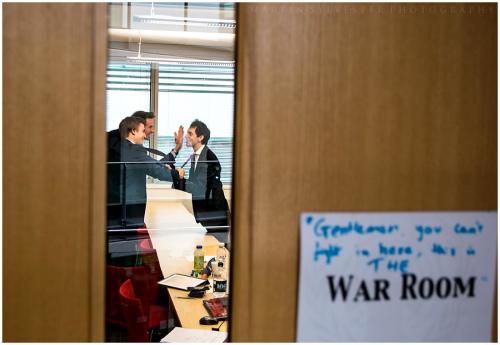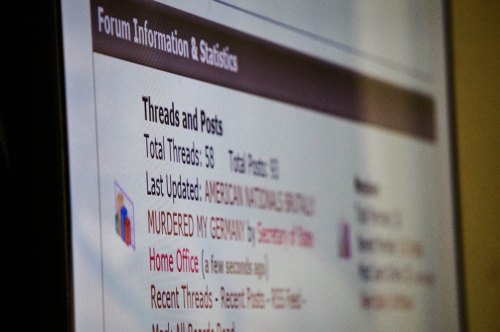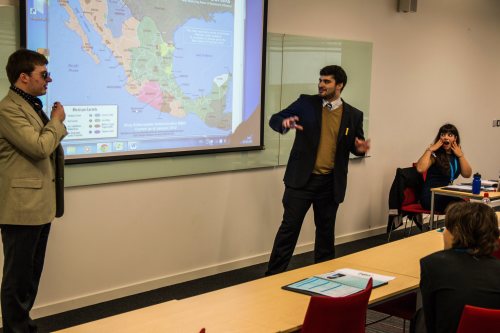
Crisis is all the rage now in Model UN. Just about every conference now has some sort of Crisis simulation – and more and more all-Crisis conferences are cropping up every year. A delegate in a Crisis committee truly has to be a delegate of action – here your ability to move quickly, be decisive, think creatively and command the room really takes the driver’s seat.
The heightened activity of a Crisis committee and the elaborate planning that goes into it makes it a bit of a challenge to introduce to Model UN society members, though – especially if you’ve only got a couple of hours a week to do it! Unlike regular MUN, the things that need teaching in Crisis don’t have to do with rules or procedure – and more to do with experience.
Here are a few ways to get your members to give Crisis a shot – you just have to make it easier for them to try out!

#1. Cut down on the research
This can seem a little counter-intuitive – in Crisis, especially historical ones, research is a major component in playing your character well and mapping out your actions, after all!
However, there’s a major difference between introducing a newcomer to regular Model UN and to Crisis – in the former, delegates can hang back and take a little time to craft speeches or plan their moves. There isn’t nearly as much pressure on a newcomer to get up and speak too often. In a Crisis, however, you can’t spend ten or fifteen minutes planning a speech or action – chances are you’ll have been left behind by then.
The result is a situation where newbies can easily feel overwhelmed – they can’t make up for any gaps in knowledge they might have, and their lack of experience means they also don’t have the confidence to just jump in. Here’s where cutting the research out can help.
Make your crisis a limited one – perhaps even a single cabinet crisis. Design a fictional crisis situation; avoid historical ones. Put together a one or two-page study guide outlining the situation, characters and character powers for your members – and leave it at that. Of course, this doesn’t eliminate research entirely – nor should it! But now that your members don’t have to go looking through the personal histories of Third Reich members or the Nixon administration, they’ll feel much less apprehensive about giving Crisis atry. And here’s a bonus: it also means you don’t have to spend days constructing a crisis that’s only going to last a few hours!
 #2. Inject a little fun – or even nonsense – in
#2. Inject a little fun – or even nonsense – in
Crisis committees always begin with serious first acts and end with insane endgames. In a typical training session, you’re not going to have much time – so why not embrace the craziness?
That’s not to say you should throw logic out the window, because that would derail your crisis. What you could do is centre your crisis around an inherently goofy or fun concept. Here’s an example: at the UN Society in Nottingham last year, we had an one-off Easter Crisis that centred around taking down a tyrannical Easter Bunny.
More recently, we had a Christmas Crisis – where members played associated Christmassy characters in two ‘cabinets’ with the objective of finding a missing Santa. That little bit of silliness helps with making the whole thing appear a little more fun and a little less self-serious to new delegates – especially ones who don’t know just how crazy and fun crisis can get!
As an added touch, making good use of props can be a great way of making your Crisis more immersive – whether it’s in a training session or at an actual conference. Other than adding to the fun factor of brandishing a (fake) AK-47 it also adds to the experience when press updates look like an actual newspaper clipping, for instance, or when a South American dictator visits your committee room dressed up in shades, a cravat and a cigar.
#3. Keep your crisis timeline focused, and give your delegates clear objectives
Unlike full conference Crises, you’ll find it hard to account for multiple contingencies in a short simulation. So keep your crisis plan simple and streamlined – and that means giving your members just one or two clear objectives. The examples I’ve mentioned above, for instance, made use of this – rather than having a series of events that give your delegates clear, binary choices (which would split your planned timeline), just map out several individual obstacles you can throw their way until time runs out and you can put your endgame into motion.
Also, the setups – ‘stop the Easter Bunny’, ‘Find Santa’ – were also useful ways of makingthe simulation more self-contained and easier to grasp for beginners. In a complex joint-cabinet crisis, newcomers easily get lost between their multiple objectives – there are military tanks to worry about on one border, a spy to fret over within the room, a financial crisis back in the state and a personal goal to achieve – how’s a newbie to cope?
By doing this, you give yourself a little more room to improvise depending on how your members do, and you (again) save yourself a little bit of hassle in planning the whole thing. Most importantly, by keeping things more streamlined, you encourage your members to actually send in directives and communiques – because they have a clear idea of what they have to be aiming for.

So you’ve had a couple of fun, holiday-themed crises. It’s time to give your members a taste of the real thing. A one-day Crisis can be a great way of putting them through something more substantial than the improvisational, less serious 2-hour simulations they’ve done in the past. Here’s where you can give them something more serious or historical – now that they’ve gotten the hang of thinking on their feet and working with directives, you can have them take on more research and preparation.
Of course, a day-long Crisis needs some preparation, even if it’s not as elaborate as a full-length conference simulation. If you’re worried about the lack of time, you can still choose a relatively self-contained narrative that’s fleshed out and serious – like the Cuban Missile Crisis (one day every hour?) or a zero-day cyber attack, or a diplomatic hostage crisis.
Hopefully, by this point your members will be able toput in the effort and handle a real simulation.
#5. Go for a conference!
The ultimate end goal of bringing Crisis to your Model UN programme is, of course, to get them to take part in an actual conference! Whether it’s a single cabinet Crisis at a regular conference, or a specialised all-Crisis conference, your members should have enough of a handle on how Crisis works to at least be an active participant through an entire weekend, if not an award-winner!
If your members are still on the beginners’ side of things, perhaps limit them to a single cabinet or dual-cabinet crisis at most. Something like a Security Council crisis or a multi-cabinet crisis may be a little more challenging for some delegates, depending on how familiar they are with things like military strength and strategy, or multitasking.
Some might argue that the best way for a delegate to pick up Crisis is to just skip the first four steps and jump right into it – and they may be right! As with Model UN in general, experience can really be your most helpful teacher here – but if you’re having trouble convincing your members to sign up for one, perhaps starting with a 2-hour session will be best. After all, the last thing you’ll want is to send them to a conference where they’ll sit quietly in a corner the whole weekend !


